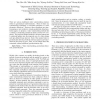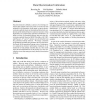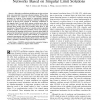798 search results - page 89 / 160 » Interval Methods: An Introduction |
SAS
2010
Springer
13 years 7 months ago
2010
Springer
Numerical Abstract Domains via Principal Component Analysis Gianluca Amato, Maurizio Parton, and Francesca Scozzari Universit`a di Chieti-Pescara – Dipartimento di Scienze We pro...
ICIP
2009
IEEE
13 years 6 months ago
2009
IEEE
There are various traditional video watermarking schemes robust to geometrical transformations. Most of them use synchronizing techniques or invariant transforms to resist geometr...
AAAI
2012
11 years 11 months ago
2012
Real-world AI systems have been recently deployed which can automatically analyze the plan and tactics of tennis players. As the game-state is updated regularly at short intervals...
ICDM
2007
IEEE
14 years 27 days ago
2007
IEEE
Data discretization is defined as a process of converting continuous data attribute values into a finite set of intervals with minimal loss of information. In this paper, we prove...
TNN
1998
13 years 8 months ago
1998
—Relaxation oscillations exhibiting more than one time scale arise naturally from many physical systems. When relaxation oscillators are coupled in a way that resembles chemical ...



